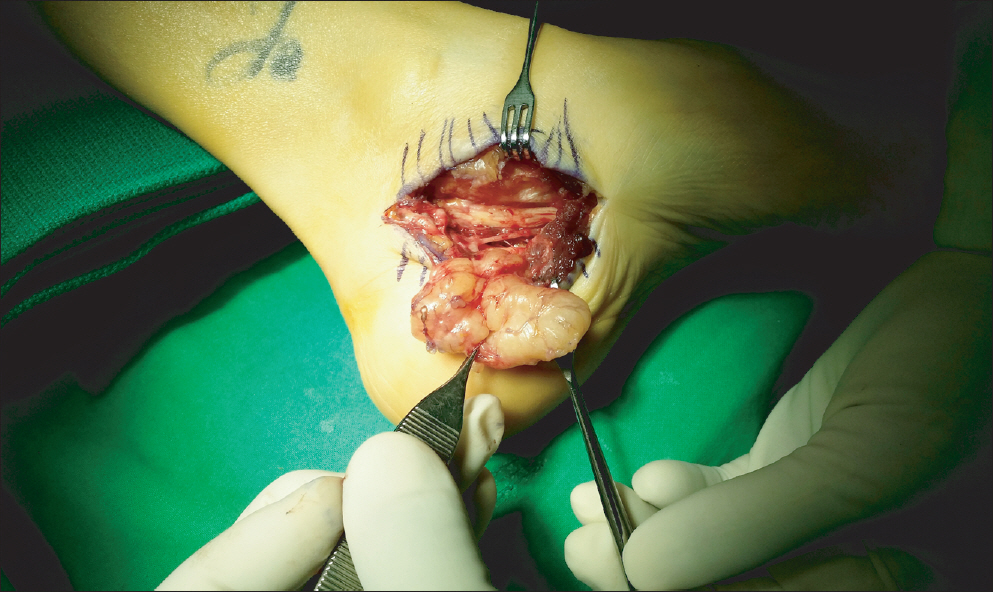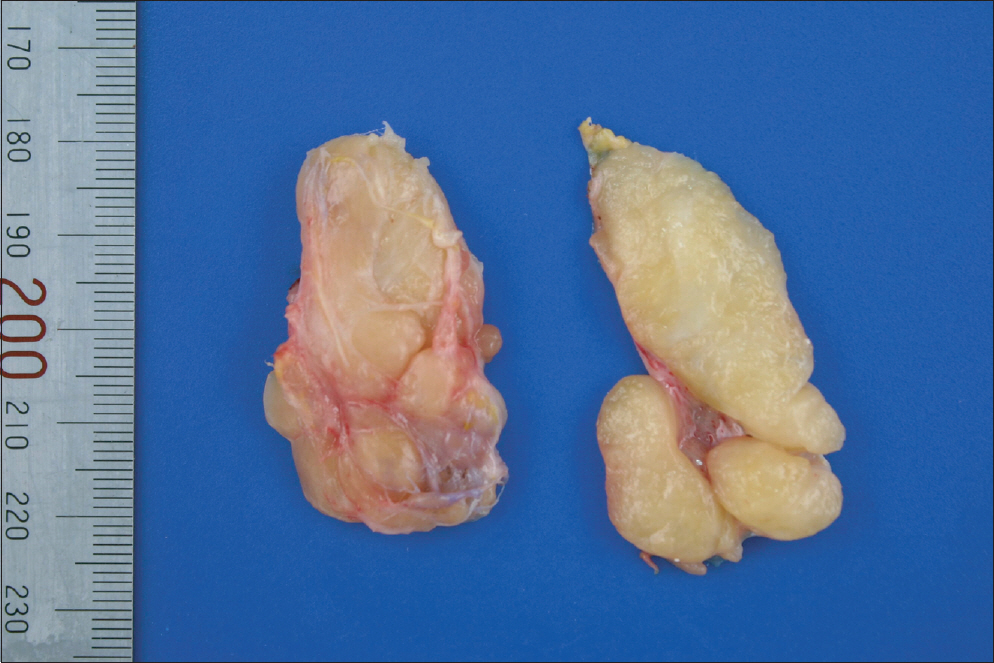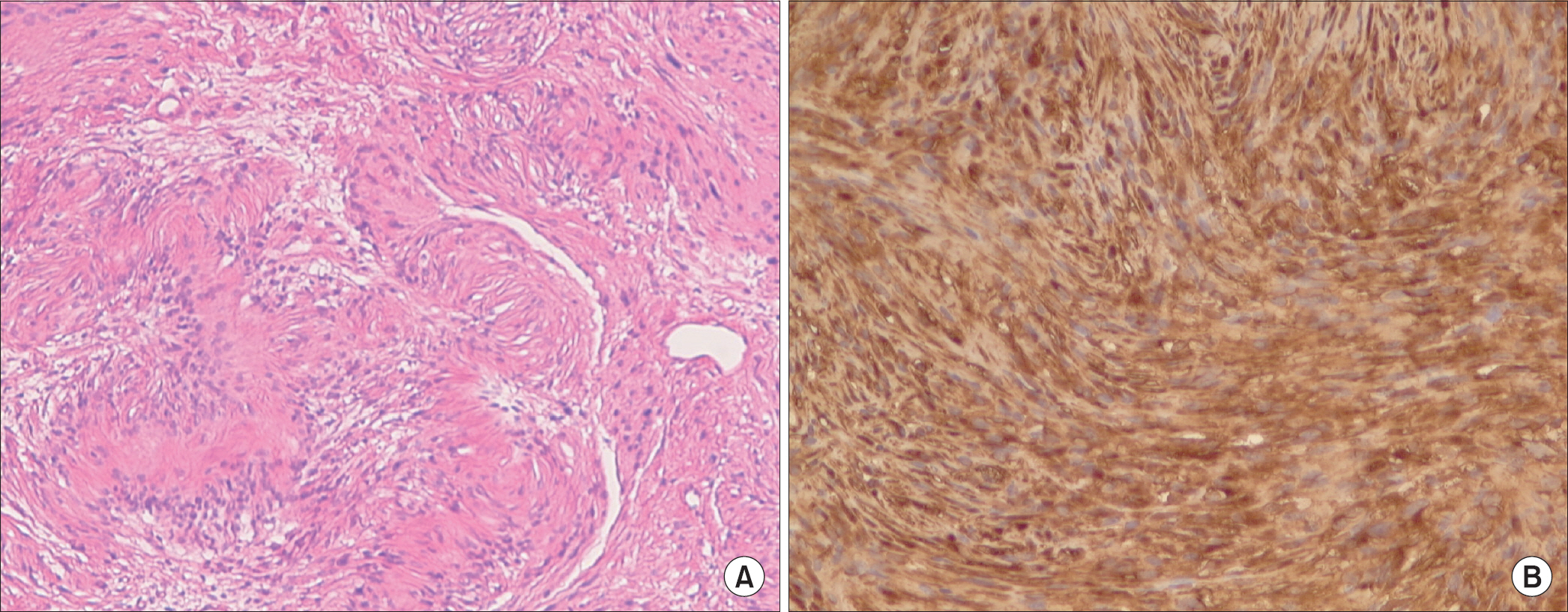J Korean Foot Ankle Soc.
2014 Mar;18(1):36-39. 10.14193/jkfas.2014.18.1.36.
Tarsal Tunnel Syndrome Secondary to Recurred Schwannoma Arising from the Posterior Tibial Nerve
- Affiliations
-
- 1Department of Orthopedic Surgery, Seoul Paik Hospital, Inje University College of Medicine, Seoul, Korea. hohotoy@nate.com
- 2Department of Pathology, Seoul Paik Hospital, Inje University College of Medicine, Seoul, Korea.
- KMID: 1958737
- DOI: http://doi.org/10.14193/jkfas.2014.18.1.36
Abstract
- Tarsal tunnel syndrome is defined as a compressive neuropathy of the posterior tibial nerve in the tarsal canal. Schwannoma is a benign tumor that arises from the peripheral nerve sheath. It presents as a discrete, often tender, and palpable nodule associated with neurogenic pain or paresthesia when compressed or traumatized. The growth rate is usually slow, and these lesions seldom exceed 2 cm in diameter. In addition, local recurrence occurs less than 5%. We report on a case of tarsal tunnel syndrome caused by a large recurred space-occupying lesion measuring 4.3x2.7x2.7 cm3.
Keyword
Figure
Cited by 1 articles
-
Update on Management of Compressive Neuropathy: Tarsal Tunnel Syndrome
Hak Jun Kim, Gyu-Sun Jang, Jiho Lee
J Korean Orthop Assoc. 2014;49(5):340-345. doi: 10.4055/jkoa.2014.49.5.340.
Reference
-
References
1. Boya H, Ozcan O, Oztekin HH. Tarsal tunnel syndrome associated with a neurilemoma in posterior tibial nerve: a case report. Foot (Edinb). 2008; 18:174–7.
Article2. Grossman MR, Mandracchia VJ, Urbas WM, Mandracchia DM. Neurilemmoma of the posterior tibial nerve with an uncommon case presentation. J Foot Surg. 1992; 31:219–24.3. Miranpuri S, Snook E, Vang D, Yong RM, Chagares WE. Neurilemoma of the posterior tibial nerve and tarsal tunnel syndrome. J Am Podiatr Med Assoc. 2007; 97:148–50.
Article4. Kwag SY, Yoon BS, Choi CS, Kim YJ. Tarsal tunnel syndrome caused by neurilemoma of the posterior tibial nerve. J Korean Orthop Assoc. 1978; 13:57–9.5. Kwon JH, Yoon JR, Kim TS, Kim HJ. Peripheral nerve sheath tumor of the medial plantar nerve without tarsal tunnel syndrome: a case report. J Foot Ankle Surg. 2009; 48:477–82.
Article6. Belding RH. Neurilemoma of the lateral plantar nerve producing tarsal tunnel syndrome: a case report. Foot Ankle. 1993; 14:289–91.
Article7. Bailie DS, Kelikian AS. Tarsal tunnel syndrome: diagnosis, surgical technique, and functional outcome. Foot Ankle Int. 1998; 19:65–72.
Article8. Varma DG, Moulopoulos A, Sara AS, Leeds N, Kumar R, Kim EE, et al. MR imaging of extracranial nerve sheath tumors. J Comput Assist Tomogr. 1992; 16:448–53.
Article9. Choi JO, An JH, Cho KH, Park BH, Hwang MS, Lee JK, et al. US findings of neurilemmoma of the extremities: pathologic correlation. J Korean Soc Med Ultrasound. 1999; 18:221–6.
- Full Text Links
- Actions
-
Cited
- CITED
-
- Close
- Share
- Similar articles
-
- Tarsal Tunnel Syndrome secondary to the Varicosis of Posterior Tibial Vein (Two Cases Report)
- Tarsal Tunnel Syndrome associated with Os Sustentaculi (A Case Report)
- Tarsal Tunnel Syndrome caused by Neurilemoma of the Posterior Tibial Nerve: A case Report
- Tarsal Tunnel Syndrome: A Case Report
- Tarsal Tunnel Syndrome Associated with Gout Tophi: A Case Report






